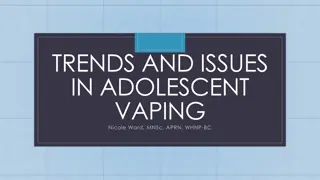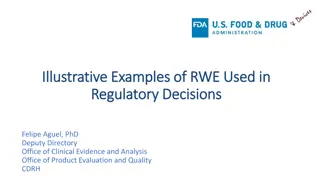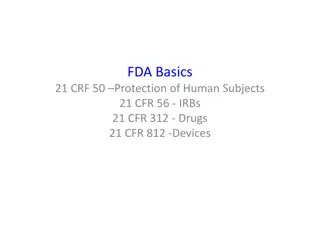Unregulated Risks of E-Cigarettes: FDA and Safety Concerns
E-cigarettes, unregulated and not FDA-approved, pose health risks with potential carcinogens and toxic chemicals. Lack of oversight allows for manufacturers to sell products with varying safety standards. FDA testing has revealed concerning findings, yet regulations are limited in addressing key issues like flavor bans and marketing restrictions.
Download Presentation

Please find below an Image/Link to download the presentation.
The content on the website is provided AS IS for your information and personal use only. It may not be sold, licensed, or shared on other websites without obtaining consent from the author.If you encounter any issues during the download, it is possible that the publisher has removed the file from their server.
You are allowed to download the files provided on this website for personal or commercial use, subject to the condition that they are used lawfully. All files are the property of their respective owners.
The content on the website is provided AS IS for your information and personal use only. It may not be sold, licensed, or shared on other websites without obtaining consent from the author.
E N D
Presentation Transcript
Tina Grosowsky, MA Project Coordinator Central MA Tobacco Free Community Partnership A program of UMass Medical School/UMass Memorial Health Care Greg Seward, MSHCA, LADC-I, CTTS-M, CADC, CAS, LSW Director, Tobacco-Free Initiative Director, Tobacco Consultation Service Instructor in Psychiatry, School of Medicine UMMMC, UMMS gregory.seward@umassmemorial.org NOTE: Audiorecording and slides will be available on: www.umassmed.edu/CCTS/Community
Disclosure We have no actual or potential conflict of interest in relation to this presentation.
What is an e-cigarette? An e-cigarette is a nicotine delivery device utilizing cartridge containing nicotine, propylene glycol and flavoring and a separate battery which heats the mixture. It is also called e-hookah , vaporizor , vape pen , mod. It contains no tobacco. Uses e-juice can be made from vegetable material. Vegetable glycerin: generally recognized as safe. When heated and vaporized, can form acrolein, which can cause upper respiratory irritation. Propylene glycol is in other consumer items, but at levels approved by the FDA, which has not occurred with e-cigs.
Types of e-cigarettes http://www.nytimes.com/2014/03/05/busine ss/e-cigarettes-under-aliases-elude-the- authorities.html?_r=0
E-cigarettes are not regulated As of today, e-cigarettes are unregulated and not approved by the FDA for use. The FDA has begun testing these devices, and has already found that in addition to the drug nicotine they may contain carcinogens and toxic chemicals such as diethylene glycol, an ingredient used in antifreeze. Vapor exhaled from e-cigarettes is from a solution that is neither FDA-approved nor analyzed to determine if the solution components are safe to inhale.
No FDA regulation FDA has issued their deeming document for proposed rulemaking, currently accepting public comment. No Consumer Products Safety Commission oversight. ANYONE can manufacture and sell. Most of the market is from China.
What FDA regulation does NOT do Does not ban flavors. Does not restrict TV ads. Does not ban marketing restrictions of any kind.
Advertising Advertising is completely unrestricted TV ads shown first time since 1971. Advertising looks like cigarette advertising. Using sexual images and seductive language. Ads in popular magazines Sports Illustrated.
What Do E-cigarettes Contain? Nicotine, propylene glycol and flavoring Diethylene glycol toxic chemical also found in some toothpastes. Symptoms of DEG poisoning: vomiting, fever, renal failure, kidney and liver failure.
Amounts of Nicotine? Because e-cigarettes are not regulated it is hard to determine how much nicotine is in each one. One e- cigarette cartridge can hold up to the same amount of nicotine as one pack of cigarettes or more. There is currently no mechanism to prevent people from filling the cartridges with other solutions.
Types of E-Cigarettes One time use = 1,000 puffs. Multi-use replacable cartridges Re-chargable battery Vaporizor Vaporizers are customizable, allowing smokers to put the devices together themselves, choosing their own refillable cartridges, heating coils and liquid drippers. Vaporizers hold more liquid than regular e-cigarettes. They produce bigger vapor clouds and last longer.
How are E-cigarettes sold? E-cigarettes can be sold to minors (under the age of 18) unless a local regulation is in place restricting the sale. E-cigarettes are being marketed and sold in areas that contain a high volume of youth, such as malls. Many communities do not have laws regulating the age in which people can purchase e-cigarettes or refill cartridges. E-cigarettes come in kid-friendly flavors such as bubble gum, cotton candy and sweet tarts.
E-cigarettes social norms E-cigarette use undermines gains that have been made to reduce the use of tobacco in public settings. Makes smokefree workplace law harder to enforce and allows vaping in places people cannot smoke. It is harder for smokers to break their addiction; and entices youth to begin smoking.
Resources www.makesmokinghistory.org www.ctfk.org www.tobaccofreemass.net www.aap.org/richmondcenter http://www.umassmed.edu/psychiatry/resources/Tob acco/Tobacco-Free-Community-Partnership/
Contact Information Tina Grosowsky Project Coordinator Central MA Tobacco Free Community Partnership Department of Psychiatry, UMass Medical School 365 Plantation Street, Worcester, MA 01605 508-856-5067 Tina.grosowsky@umassmed.edu
Greg Seward, MSHCA, LADC-I, CTTS-M, CADC, CAS, LSW Director, Tobacco-Free Initiative Director, Tobacco Consultation Service Instructor in Psychiatry, School of Medicine UMMMC, UMMS gregory.seward@umassmemorial.org Data privacy and security symposium on offered by Commonwealth Medicine http://www.umassmemorialcareers.org/files/images/main/top_logo.gif
This products are often not called e-cigarettes by users. Other names include E-CIG, e-hookah, shisha pens, vape pens and electric cigarettes
Propylene Glycol Propylene glycol is one of two main base ingredients of e-liquid. Dow Chemical Company states to avoid inhalation exposure to propylene glycol mists American Chemistry Council warns against its use in theater fogs because of the potential for eye and respiratory irritation When heated and vaporized, propylene glycol can form propylene oxide, an International Agency for Research on Cancer class 2B carcinogen https://encrypted-tbn0.gstatic.com/images?q=tbn:ANd9GcTbKfzBQm500NqcVy68cFXCRVWXwXfDAgs61UiLKNi_zBObWRZ8o-CGMuE Circulation. 2014;129:1972-1986 https://encrypted-tbn2.gstatic.com/images?q=tbn:ANd9GcSeqU391RmwyfXWfuxsllraUl8P1xZCiKOo74MnodD94BKlOStoy7Qtog
British Doctors Study (1951-2001) The mortality of doctors in relation to their smoking habits in 1956 provided convincing statistical proof of linkage between smoking and lung cancer, MI MI, respiratory disease and other smoking-related illnesses This was a prospective cohort study of registered physicians in the UK Will we follow a similar path with E-CIG s? www.ncbi.nlm.nih.gov/pmc/articles/PMC437141/pdf/bmj32801529.pdf Richard Doll.jpg Sir William Richard Doll (1912 2005) https://encrypted-tbn1.gstatic.com/images?q=tbn:ANd9GcRJd1Vtbx6uGY4xbh_AoZS4DGswCCTs82ozen1xuD3aDtt04NvN8kzHLZc
Poison centers are reporting increases in calls about exposures to E-CIG s and liquid nicotine (219% 2013 from 2012) 50% of these reported exposures have occurred in children under the age of 6 consistent with National Poison Data System exposures to all substances combined. Some have become very ill; some requiring ER visits with nausea and vomiting being the most significant symptoms. Use care to protect skin when handling the products, and keep them out of sight and reach of children. Dispose of them properly to prevent exposure to pets and children from the residue or liquid left in the container. www.aapcc.org/alerts/e-cigarettes
Infant Who Swallowed E-Cigarette Refill Liquid Highlights Emerging Danger May, 2014 - Philadelphia With the growing use of e-cigarettes, physicians need to be alert for nicotine poisoning http://www.nlm.nih.gov/medlineplus/news/fullstory_146 117.html Dr. Robert Bassett, of Einstein Medical Center, reported in the May 7 issue of the New England Journal of Medicine. Just "one teaspoon of a 1.8% nicotine solution could be lethal" to a 200 lb person http://www.nejm.org/doi/full/10.1056/NEJMc1403843 Conflicting reports and data re: human toxicity Animal studies Reports of survival at higher dose Arch Toxicol. 2014; 88: 5 7.
Nicotine poisoning symptoms Call 1-800-222-1222 Red Vault Premium Vapouriser Poisoning from liquid nicotine can happen in 3 ways: swallowing it; inhaling it; or absorbing it through the skin or membranes in the mouth and lips or eyes initial symptoms (mainly due to stimulatory effects): nausea and vomiting, excessive salivation, abdominal pain, sweating, tremor, headache, dizziness, seizures, etc. later symptoms can occur: symptoms of hypotension, bradycardia, CNS depression, coma, muscle weakness / paralysis difficulty breathing or respiratory failure. Ideally know: patient's age, weight, and condition, name of product (as well as the ingredients and strength if known, when it was swallowed or inhaled and the amount swallowed or inhaled
Massachusetts and Rhode Island Poison Control Center data 2010: 0 calls 2011: 2 calls (2 adults one age 29, one age 20-29) 2012: 4 calls (18 month old, 2 years, 20-29 year old, 33 year old) 2013: 8 calls (20 + 23 month olds; 3, 7, and 10 years old, 2 adults) 2014: 2 calls (20 months and 24 years)
Puppys overdose on e-cigarette The owner urged the makers of e-cigarettes to warn users that the fluid can be lethal WHO: swallowing between 0.5mg and 1mg per kg of the drinker s weight can prove fatal http://metro.co.uk/2014/02/18/puppys-overdose- on-e-cigarette-could-have-killed-a-child-4309310/
Secondhand e-cigarette aerosol: not just water vapor People exposed to aerosol exhaled by the user. metals in e-cigarette aerosol include chromium, nickel, and tin nanoparticles Exhaled e-cigarette aerosol contains propylene glycol, glycerol, flavorings, and nicotine, along with acetone, formaldehyde, acetaldehyde, propanal, diacetin, and triacitine At least 10 chemicals identified in e-cigarette aerosol are on California s Proposition 65 list of carcinogens and reproductive toxins, People exposed to e-cigarette aerosol absorb nicotine (measured as cotinine), with one study showing levels comparable to passive smokers. The amount of 2nd hand exposure to nicotine from E-CIG s is about 1/10 that of tobacco cigarettes but it is still there. More research is needed to evaluate health consequences of this exposure especially with vulnerable populations such as children, pregnant women and people with cardiovascular conditions http://no-smoke.org/pdf/ecigarette-secondhand-aerosol.pdf Circulation. 2014;129:1972-1986 Nicotine and Tobacco Research, December, 2013
Syracuse hospital bans e-cigarettes after patient on oxygen catches fire while using one: 4/22/14 The patient was burned across her face from ear to ear said St. Joe's spokeswoman. The patient had an e-cigarette in her mouth and was using oxygen when the fire started. www.syracuse.com/news/index.ssf/2014/04/syracuse_hospit al_bans_e- cigarettes_after_patient_catches_fire_while_using_one.html
E-CIGs and explosions E-cigarette explodes in barmaid s face after being put on iPad charger http://metro.co.uk/2014/04/08/video-e-cigarette-explodes-in-barmaids- face-after-being-put-on-ipad-charger-4692238/ Electronic cigarette explodes in man's mouth, causes serious injuries http://www.cbsnews.com/news/electronic-cigarette-explodes-in-mans- mouth-causes-serious-injuries/
Nicotine: Benefits? nicotine without its host tobacco may have some benefits at low doses: Some human and animal studies have shown benefits as: a cognitive enhancer stimulates memory and alertness Decreases appetite, increases intestinal activity treatment for relieving or preventing a variety of neurological disorders (Scientific American, 2/9/14) In FDA approved products for nicotine withdrawal
Used as an insecticide After WWII over 2,500 tons of nicotine insecticide were used worldwide by the 1980s the use had declined below 200 tons. This was due to the availability of other insecticides that are cheaper and less harmful Currently, nicotine is prohibited as a pesticide for organic farming in the United States
https://encrypted-tbn0.gstatic.com/images?q=tbn:ANd9GcTKIybH3f19TZgnumSWKlMjn1nYycSlXH06RXjuhS2MiwiUsTViZyy6Dmghttps://encrypted-tbn0.gstatic.com/images?q=tbn:ANd9GcTKIybH3f19TZgnumSWKlMjn1nYycSlXH06RXjuhS2MiwiUsTViZyy6Dmg Pesticide Nicotine-Derived Pesticides Are Killing Canada's Bees www.vice.com/read/nicotine-derived-pesticides-are-killing-all-of- canadas-bees Nicotine sulfate is the most hazardous botanical insecticide available to home gardeners extracted from tobacco by steam distillation or solvent extraction. Highly toxic to humans and other warm blooded animals (rapidly absorbed through the skin) 6 times more toxic than diazinon www.herbmuseum.ca/content/tobacco-dust
FDA approved cessation devices: Patch, lozenge, gum, inhaler, NS, Chantix, Zyban None of these meds have CO, or any risk of fire, or explosion, or second hand vapor. They have been studied and approved by FDA Inhaler: (Nicotine >mouth, not lungs as E-CIG) safer option worth considering The E-Cig delivers nicotine into the lungs as does smoking regular cigarettes. There are studies showing dual use. Too similar an agent to promote quitting. Not proven safe and effective by FDA
What to tell patients who want to use E-Cigs as part of quitting: Don t undermine motivation to quit! The safest and most proven smoking cessation pharmacotherapies are the 7 FDA approved meds Referral for counseling (UMass TCS 508-334- 5393 or QW 800-QUIT-NOW enhances effectiveness of meds If patient insists on using E-CIG s then:
Patients should be informed that: https://encrypted-tbn2.gstatic.com/images?q=tbn:ANd9GcR52x6Ps739xAynkSt66rYT52cstAAqR970tT9RUud-PtXbpiyDfMTInd84jA E-cigarette aerosol is likely to be less toxic than cigarettes, BUT the products are unregulated, do contain toxic chemicals, and have not been proven as cessation devices. Do not use product indoors, around children or pets (exposure to nicotine and toxins through passive exposure) Do not use around oxygen (risk of fire) Use only approved charging devices (risk of explosion) There is a risk of explosion (documented reports even not while charging) Banned use in many places (hospitals, airlines, trains, public places, etc) so be prepared (may want to try NRT) There are no long-term safety studies of e-cigarette use: patients should be urged to set a quit date do not plan to use indefinitely Secure E-Cig s and refillable liquid away from kids and pets E-CIG s cost more than NRT medications Work on plan
Why not do what works best? Medication + Counseling = highest success rates Quitworks: 1-800-QUIT-NOW UMass TCS: (508-334-5393) Nicotine-Anonymous: www.nicotine- anonymous.org NRT s may be covered by insurance copay s may be cheaper, also cheaper than most smoking or e- cig s
Research Gaps What information does the FDA need in order to regulate e-cigarettes? How should they be regulated? Who is using e-cigarettes? Why? When? Health impacts of e-cigarettes to the person using them Children Teens Adults, including reproductive effects Reproductive effects on current adults and children Health impacts of second-hand vapor Children Teens Adults, including reproductive effects Reproductive effects on current adults and children Toxicity of different doses of nicotine Prevalence of nicotine liquid poisoning -Who is at risk? What other substances are being used with e-cigarettes? Who is using them? When? Where? What are the effects? What effect is the unregulated marketing having on use of e-cigarettes among children and teens? How are e-cigarettes being used for cessation? What are the successes? What are the risks? Rates of new nicotine addiction among different ages and populations Safety of flavors and other additives
Next Webinar Using Social Media to Disseminate Health Messages to the Community and Beyond August 14th, from 10:00 11:30 AM. Sherry Pagoto, PhD Associate Professor Division of Preventive and Behavioral Medicine UMass Medical School
Save the Date! Community Engagement and Research Symposium Friday, November 7th, 2014 Albert Sherman Center UMass Medical School Worcester, MA























